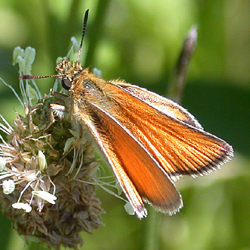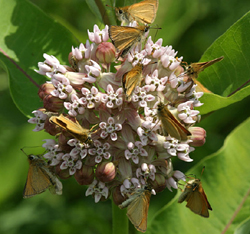Find a Butterfly
European Skipper
Thymelicus lineola
Named
Ochsenheimer, 1808

Taxonomy & Nomenclature
The English name for this species within its native range is Essex Skipper.
Identification
Wingspan 3/4"-1". Overall orange appearance. Wings above with black veins and narrow black borders. Hindwing beneath with gray-green suffusion over orange ground color. The male has a tiny stigma line. Similar species are Least Skipper, which is smaller with predominantly dark forewings, and Delaware Skipper, which is larger, longer winged and bright yellowish beneath with a more prominent pattern of lines around the descal cell (See species account). In Europe this species is often confused with the very similar Small Skipper (T. sylvestris) which is also a very common pasture grass feeder; it‘s cryptic presence here is not implausible.
Distribution
Native to Europe and western Asia, this butterfly was accidentally introduced into North America at London, Ontario about 1910. Its current distribution is southern Manitoba east to Newfoundland and south to Missouri and Virginia. A disjunct population, discovered in 1960, is spreading in British Columbia. Range rapidly expanding, in large part due to human assistance (see Notes).
Status in Massachusetts
The European Skipper is a recent immigrant into New England; the first regional record was 25 June 1963 in central Connecticut (Apter and Burns, 1965). Since then, the species has spread northward throughout New England and is ubiquitous during its summer flight period, often far outnumbering all other species combined at favored locales. During the Atlas project, European Skippers were found in all parts of Massachusetts, including the Islands. Concentrations of these skippers may, at times, be remarkable as evidenced by the following record calculated from a 2- hour transect count. Maximum: 28,000 on 24 June 1992, Mansfield (Bristol Co.), B. Cassie, most nectaring at Common Hawkweed and Cow Vetch.
The species is also expanding its range in Europe generally northward.

Flight Period in Massachusetts
Single-brooded, with peak flight in late June/early July. Extreme dates are 3 June 1991, Milford (Worcester Co.), T. Dodd and 29 July, Edgartown (Dukes Co.), C. Leahy.
Larval Food Plants
Grasses (mainly introduced pasture grasses) especially Timothy, (Phleum pratense), on which it may occur in pest proportions.
Adult Food sources
Milkweeds and pea species, especially Cow Vetch and Birdsfoot Trefoil, attract the greatest numbers of European Skippers. Scott (1986) reports that these butterflies are attracted to lady slipper (Cypripedium) orchids into which they climb for nectar (and become trapped and die).

Habitat
Open dry meadows at all elevations serve this species to perfection.
Life Cycle
EGG: Whitish; flattened, and hemispherical. OVIPOSITION: Eggs laid in strands of 25-30 on the host grass leaf sheath or seed head. LARVA: Green, with a dark stripe down the back, and two yellowish stripes on a light brown head. PUPATION: Along lower stems of the host plant. CHRYSALIS: Green, with dark stripe along top surface and a pointed projection at the head end. OVERWINTERING STAGE: As eggs.
European Skippers are on the wing from early June to early or mid-July and during that period they are by far the most common butterfly species in our region. Large numbers of European Skippers congregate at wildflowers, and sometimes their concentrations are remarkable: one 700 square foot patch of Birdsfoot Trefoil in Millis nourished 1000 European Skippers at once, with few other species present. The species is known to form evening communal roosts (Hensel, 1966), although this behavior has yet to be documented in Massachusetts. The spread of the European Skipper across North America has been greatly hastened by humans, who unwittingly transport millions of eggs on hay across the countryside. Eggs are laid in early summer but do not hatch out until the following year.
Account Author
Brian Cassie



